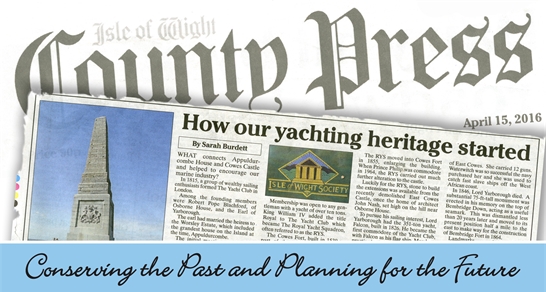How our yachting heritage started
What connects Appuldurcombe House and Cowes Castle and helped to encourage our marine industry?
In 1815 a group of wealthy sailing enthusiasts formed The Yacht Club in London. Among the founding members were Robert Pope Blachford of Osborne House and The Earl of Yarborough. He had married the heiress to the Worsley Estate which included the grandest house on the Island at the time, Appuldurcombe.
The initial meeting was held in London. Subsequent meetings were held twice a year in East Cowes. The Medina Hotel was their venue, approximately where the Columbine Shed with its large Union Flag stands today. Membership was open to any gentleman with a yacht of over ten tons. King William IV added the title Royal to The Yacht Club which became The Royal Yacht Squadron, often referred to as the RYS.
The Cowes Fort, built in 1539 as part of the Henry VIII defences against the French, was one of a pair protecting the Medina River. The one in East Cowes was built on clay, and cracked badly, so was abandoned. The Cowes one also suffered from subsidence, but was repaired, several times. The RYS moved into Cowes Fort in 1855, enlarging the building. When Prince Philip was Commodore in 1964 the RYS carried out much further alteration to the castle. Luckily for the RYS, stone to build the extensions was available from the recently demolished East Cowes Castle, once the home of architect John Nash, set high on the hill near Osborne House.
To pursue his sailing interest Lord Yarborough had the yacht Falcon, of 351 tons, built in 1826. He became the first Commodore of the Yacht Club, with Falcon as his flag ship. Members practised sailing in formation, as well as racing. They offered their yachts as a reserve to the Admiralty and the crews signed articles whereby they agreed to the harsh discipline of the Navy, albeit on private yachts.
The brig Waterwitch was an experimental yacht, built for RYS member Lord Belfast in 1832 by Joseph White of East Cowes. She carried twelve guns. Waterwitch was so successful that the Navy purchased her and she was used to catch fast slave ships off the West African coast.
In 1846 Lord Yarborough died. A substantial 75 foot tall monument was erected in his memory on the top of Bembridge Down, acting as a useful seamark. This was dismantled less than twenty years later and moved to its present position half a mile to the east to make way for the construction of Bembridge Fort in 1864.
Landmarks such as the Yarborough Monument and Cowes Castle remind us of our history. The RYS members encouraged the building of yachts on the Medina, and this provided work for many in construction, maintenance and crewing. Thanks to Lord Yarborough and others, the Royal Yacht Squadron and Cowes Week are part of our Island Heritage and continue to encourage our marine industry.
[Go Back]

